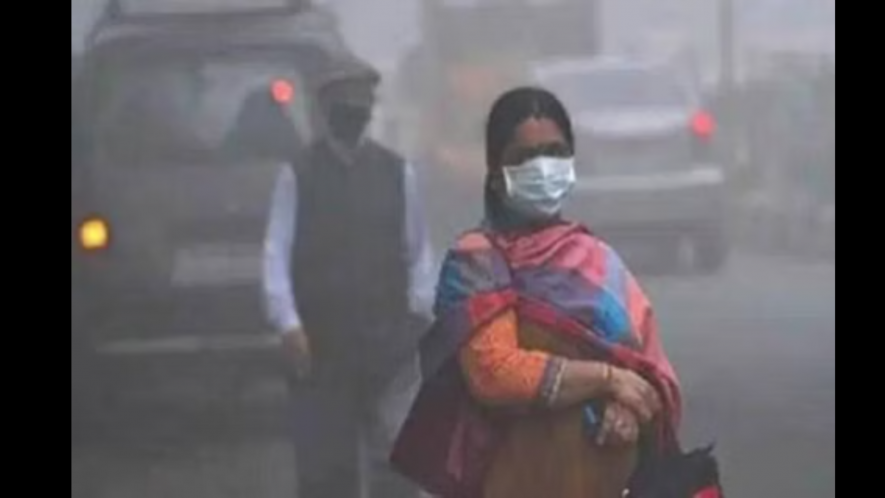Bihar: Poor Air Quality Affecting People's Respiratory Health

Representational Image. Image Courtesy: PTI
Patna: The number of people complaining of breathlessness, burning sensation in eyes, chest infection, coughing, allergy, and asthma has been increasing in hospitals across Bihar, including Patna, in recent days, thanks to worsening air pollution.
Poor air quality is not new here, but increasing air pollution during the ongoing winter season affects people's health. This was revealed by the doctors of the different government-run hospitals.
People have been facing health problems in the state due to poor air quality and increasing pollution, as indicated by the official data of the Central Pollution Control Board(CPCB).
As per the AQI bulletin of CPCB on December 23, two cities -Begusarai and Siwan recorded severe AQI of 450 and 407. Nine other cities recorded very poor AQI —Patna (374), Arrah (308), Samastipur (386), Bettiah (373), Bhagalpur (368), Bihar Sharif (317), Chapra (399), Darbhanga (375), and Hajipur (326).
Similarly, air quality in many places in Bihar was very poor to severe on Saturday (December 24 at 8.30 am as per AQI). Four cities recorded very poor AQI - Saharsa (409), Bhagalpur (337), Begusarai (311), and Purnea (302).
CPCB's AQI data of the last three weeks established that nearly half of the most polluted cities in the country were from Bihar, with a tag of severe to very poor category. The state has recorded 'severe' AQI for 19 days between December 1-20, except on December 6.
According to CPCB, AQI of the very poor category causes respiratory illness on prolonged exposure. AQI of the severe category affects healthy people and seriously impacts those with existing diseases.
Health specialists of the government-run Patna-based All India Institute of Medical Sciences, Patna (AIIMS Patna), Indira Gandhi Institute of Medical Sciences (IGIMS), Patna Medical College and Hospital PMCH, and Nalanda Medical College and Hospital (NMCH ) admitted that increasing air pollution affects the lungs, causing chest infection, breathlessness, allergy, coughing, wheezing, and infections.
Dr Deependra Rai, who works at Pulmonary Medicine, AIIMS Patna, told NewsClick that the number of patients suffering from respiratory illness, lung problems, and chronic obstructive pulmonary disease (COPD) has increased.
"Several patients visit us for treatment after falling seriously ill due to poor air quality. The number of such patients is increasing."
Dr RK Singh, who works at ENT of IGIMS, said increasing air pollution has resulted in many patients visiting us with respiratory diseases, breathlessness and infection in the airways and nose.
PK Agarwal of pulmonary medicine at the PMCH told NewsClick that air pollution had affected health. Many patients visiting the Outdoor Patient Department suffer from shortness of breath, breathlessness, other respiratory diseases, and COPD.
These doctors suggested people avoid dust particles and smoke on roads as much as possible and use masks as protective measures.
According to environmental experts, the AQI level of the severe category can prove very harmful as inhalation of toxic air containing pollutants like PM 2.5, carbon monoxide, sulphur dioxide, and carbon dioxide are dangerous for healthy people. But it will affect people suffering from lung, heart and other diseases even more.
The severe air quality levels are already affecting thousands of people, including workers, rickshaw pullers, autorickshaw drivers and the economically-weaker sections who spend most of their time on the road to earn their livelihood.
"I suddenly developed breathlessness and weakness early this week and visited OPD at a government-run hospital. Doctors informed me that it was due to increasing air pollution as I spent hours near the road. I never imagined that air pollution would hit me because I never bother about it like thousands of others," Deepak Mahto, a middle-aged vendor on the pavement near the busy Rajabazar area in Patna, said.
After doctors advised him to avoid dusty and smoky environments, Mahto is now using a mask and drinking plenty of water to minimise air pollution's effect on his health.
"Air pollution is unbearable. It is difficult to breathe sometimes, burning sensation in eyes is common, and several people have complained of respiratory illness," Mahto told NewsClick.
Mahto recalled that he has been doing business on the roadside for over two decades in Patna, and air quality was better a decade ago than it is now.
Basawan Paswan shared Mahto's concern; he is a hand cart puller diagnosed with respiratory disease due to air pollution last week.
"Doctors suggested I avoid dust and smoke to keep my lungs healthy. But I am a poor man, earning a livelihood by working hard for hours since the late 90s in Patna when there was nothing like breathlessness, burning sensation in my eyes, smoke and dust all around as it is nowadays. I have no option other than to work with breathing problem," Paswan told NewsClick.
A similar opinion was expressed by Mintu Singh, a garment shop owner near Patna Railway station.
"Increasing air pollution has become a big problem for all, rich and poor alike because all breathe the same toxic air. It is bound to create health problems. Air pollution is increasing yearly; the common people are facing the brunt of it."
However, Bihar State Pollution Control Board's (BSPCB) chairman Ashok Kumar Ghosh said there are several factors behind the deteriorating air quality here. But Bihar's Indo-Gangetic geographical position is primarily responsible for the increase in AQI during the winter season.
Ghosh said several measures had been taken to control air pollution from vehicles, biomass burning, dust particles, low temperature, high moisture level and low wind velocity.
Earlier, S Chandrashekhar, member secretary of the BSPCB, reportedly claimed that some geographical factors are also behind the rise in air pollution.
Early this year, it was revealed in the latest All-India winter air quality analysis by the Centre for Science and Environment (CSE), a New Delhi-based non-profit organisation, that Bihar was one of the most polluted regions in the country during the winter of 2021-22 (October 15 to February 28). The winter average of PM2.5 in the eastern plains includes the newly monitored 19 cities and towns of Bihar, the same as that of Delhi-NCR. Six Bihar towns feature in the top 10 most polluted cities this winter, with Siwan and Munger at the top. In the northern plains, Ghaziabad, Delhi, Faridabad, and Manesar are third, fifth, seventh, and tenth, respectively. Even though the seasonal average in smaller cities of Bihar rivals the megacities of NCR, their peak pollution during smog episodes is comparatively milder.
Smaller cities of Bihar recorded higher pollution during winter than big cities of Delhi-NCR: Siwan in Bihar was the most polluted city in India this winter, with a seasonal average of 187 ug/m3. Thirteen cities of Bihar feature in the top 25 cities with the highest levels in winter. Delhi-NCR had 11 cities on the list. Hisar in northern Haryana was the only city in the top 25 outside the sub-regions of Bihar and NCR.
Get the latest reports & analysis with people's perspective on Protests, movements & deep analytical videos, discussions of the current affairs in your Telegram app. Subscribe to NewsClick's Telegram channel & get Real-Time updates on stories, as they get published on our website.






















